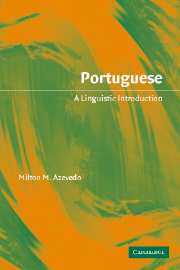Book contents
- Frontmatter
- Contents
- List of maps
- List of tables and figure
- Acknowledgments
- List of abbreviations and symbols
- Introduction
- 1 The Portuguese language in the world
- 2 Sounds
- 3 Words
- 4 Sentences
- 5 Portuguese in time
- 6 The expansion of European Portuguese
- 7 Brazilian Portuguese
- 8 Sociolinguistic issues
- Suggestions for further reading
- Glossary
- Bibliography
- Index
5 - Portuguese in time
Published online by Cambridge University Press: 05 September 2012
- Frontmatter
- Contents
- List of maps
- List of tables and figure
- Acknowledgments
- List of abbreviations and symbols
- Introduction
- 1 The Portuguese language in the world
- 2 Sounds
- 3 Words
- 4 Sentences
- 5 Portuguese in time
- 6 The expansion of European Portuguese
- 7 Brazilian Portuguese
- 8 Sociolinguistic issues
- Suggestions for further reading
- Glossary
- Bibliography
- Index
Summary
In Chapter 1 we glanced at the external history of Portuguese, and in Chapters 2 through 4 we examined aspects of its sounds, word forms, and the structure of phrases and sentences. In doing this we followed a synchronic° perspective, looking at the language in its contemporary state, without taking into account historical factors, as though the language were fixed in time.
As time goes by, however, every language undergoes a variety of diachronic° processes that substantially affect all of its components and which constitute its internal history. Such modifications affect sounds (phonetic and phonological change), the shape of words (morphological change), the structure of phrases and sentences (syntactic change), the make-up of the lexicon (lexical change), and the meaning of words (semantic change). Given enough centuries, a language can be changed into a substantially different one. In this chapter we will consider some of the diachronic processes responsible for transforming popular spoken Latin into Portuguese.
The Latin source
Although it is difficult to observe diachronic processes directly, we have sufficient data about Latin and early forms of Romance, provided by ancient manuscripts, inscriptions, and grammarians' comments about the language. By comparing such information with data from today's Romance languages, we can make reasonable conjectures about what happened. A major obstacle, however, is that understanding those processes requires a knowledge of Latin, which most students nowadays lack.
- Type
- Chapter
- Information
- PortugueseA Linguistic Introduction, pp. 147 - 181Publisher: Cambridge University PressPrint publication year: 2005



